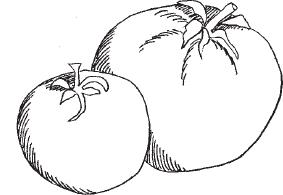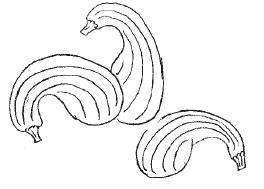Nourishing Traditions: The Cookbook That Challenges Politically Correct Nutrition and The... (114 page)
Authors: Sally Fallon,Pat Connolly,Phd. Mary G. Enig
Tags: #Non-Fiction, #Reference, #Science, #Health
Can anyone imagine Italian or Greek cooking without the tomato? And yet the tomato is another newcomer to European cuisine, an import from the New World. When the tomato was first introduced to European tables, and before it became common fare, it was called the "love apple" and was reputed to be an aphrodisiac. This reputation faded after tomatoes became available to the masses. In America the tomato was long held in suspicion and considered poisonous by the Puritans—perhaps out of fear of its aphrodisiac qualities. As this apprehension faded, the tomato became our most popular garden vegetable.
TOMATOES
Tomatoes are often served boiled or stewed—a particularly nasty way to ruin a tomato. But they are very nice baked.
Baked Tomatoes
Serves 4
8 firm plum tomatoes
2 tablespoons extra virgin olive oil
2 tablespoons Rapadura (see
Guide to Natural Sweeteners
)
Brush tomatoes with olive oil and set in an oiled pie plate. Bake at a very low temperature (200 degrees) for at least 4 hours. Sprinkle on Rapadura, raise heat to 300 degrees and bake another 20 or 30 minutes. The tomatoes will become browned and slightly caramelized. These are delicious with red meats.
Tomatoes are well known for their vitamin C content. They also contain carotenoids, B complex, potassium, magnesium, phosphorus and calcium. Unfortunately, many tomatoes are picked green and then treated with ethylene gas, which causes them to turn red without really ripening. These tomatoes have the flavor and texture of cardboard and are nutritionally inferior. Canned tomatoes, picked at the peak of ripeness, surpass most store-bought tomatoes in nutritional qualities. Organic canned tomato products, with no salt added, are now sold in many stores. Even better, fresh organically grown and vine-ripened tomatoes are now becoming more available. Hydroponically grown tomatoes, while perfect in appearance, lack both nutrients and flavor.
To bring store-bought tomatoes to the peak of ripeness, place them upside down in a sunny windowsill. When ripened they will keep about a week refrigerated.
As for the therapeutic benefits of the tomato, they are high in a carotenoid called lycopene that seems to be of great value in protecting us from cancer. Other studies have shown them to be helpful in preventing appendicitis.
On the down side, some individuals are allergic to tomatoes. This is probably due to the fact that many people consume tomatoes in the form of tomato sauces and other tomato products to the exclusion of other vegetables. The solution to this problem is to eat a variety of vegetables, and keep the tomato in its proper place—as one of a great many vegetables that should be eaten on a regular basis but not to excess. SWF

Stuffed Tomatoes
Serves 6
3 large tomatoes
sea salt and pepper
2 slices whole grain bread
2 tablespoons butter, softened
2 tablespoons Parmesan cheese, grated
½ teaspoon fine herbs
Slice tomatoes in half around the equator, remove seeds and place cut side up in a buttered baking dish. Sprinkle with a little sea salt and pepper. Process bread in a food processor to make fine crumbs. Add butter, cheese and herbs and pulse a few times until well blended. Spread a spoonful of stuffing over each tomato half. Bake at 350 degrees for about 30 minutes.
TURNIPS
This European favorite, and its cousin the rutabaga, is rarely seen on American tables—and yet it was a staple in the early American farmers' diet, usually mashed up with plenty of butter and cream. The following recipes do justice to this neglected vegetable.
Turnip Puree
Serves 6
3 pounds turnips
2-3 baked potatoes
¾ cup
piima cream
or
creme fraiche1 teaspoon dried thyme
sea salt and pepper
Peel turnips and cook in salted filtered water for about 45 minutes or until tender. Scoop flesh out of potatoes and add to turnips. (Reserve skins for
potato skins
.) Mix in the cream, thyme and seasonings to taste. Transfer to an buttered ovenproof casserole and reheat at about 200 degrees.Variation: Rutabaga Puree
Use
3 pounds rutabagas
instead of turnips.
Turnips and related vegetables like rutabagas do not test high in vitamins but are very rich sources of potent cancer-fighting substances called glucosinolates.
Turnips probably originated in Russia or Scandinavia. They were a staple food in American and European diets until recent times because of their keeping qualities—they could be stored over the winter in root cellars, ready to be cooked up and mashed as a puree or added to soups and stews. This inexpensive cancer-fighter deserves a comeback. They are delicious pureed and can be added to roasting pans, soups and stews. SWF
Glazed Turnips
Serves 6
2 pounds turnips, peeled and quartered
4 tablespoons butter
1 cup
beef stock1 teaspoon gelatin (See
Sources
), optional1 tablespoon parsley, finely minced
Plunge turnips into boiling salted, filtered water for 3 to 5 minutes. Drain and pat dry. Saute in butter until lightly browned. Add stock and optional gelatin and boil down until turnips are coated and liquid has almost completely evaporated. Sprinkle with parsley and serve.
Squash is another vegetable that hails from the New World. The Massachusetts Indians called it
askutasquash
. Squash is a member of the gourd family and a relative of cucumbers and melons. The numerous varieties can be divided into two main categories: summer squash has soft skin and includes zucchini and crook necked or yellow squash; winter squash has a harder rind and includes butternut and spaghetti squash.
Both types provide carotenoids and vitamin C plus potassium, calcium and fiber. Winter squash is a better bet nutritionally, but summer squash is more versatile from the cook's point of view.
The American Indians valued the seeds of both squash and pumpkin for various ailments, but the pulp also has pharmacological properties, notably anticancer carotenoids. Winter squash and other deep orange vegetables are especially effective in preventing lung cancer. SWF
YELLOW SQUASH
If you want your children to hate squash, just serve it to them boiled. Nothing could be slimier or more unappetizing. Instead, slice it lengthwise and saute the slices in butter and olive oil. Finish with sea salt, pepper and a squeeze of lemon juice.
Yellow Squash Medley
Serves 4
4 small yellow squash
sea salt
1 medium onion, thinly sliced
2 medium tomatoes, peeled, seeded and chopped
2 tablespoons
crispy pine nuts1 tablespoon finely chopped parsley
4 tablespoons extra virgin olive oil
To peel tomatoes, see
Kitchen Tips and Hints
. Remove ends from squash and use food processor to cut them into a julienne. Sprinkle with sea salt and let sit about 1 hour. Rinse well and squeeze dry with a tea towel. Saute onion in olive oil until golden. Add squash and tomatoes and saute a few minutes more, over medium-high heat, stirring constantly. Stir in pine nuts and parsley.
Yellow Squash Supreme
Serves 4
4 large yellow squash
about 3 tablespoons extra virgin olive oil
¾ cup grated Parmesan cheese
about 1 tablespoon cracked pepper
Wash squash, remove ends and slice lengthwise at ¼-inch intervals. Brush a cookie sheet with olive oil and arrange the slices in one layer. Brush top side with olive oil and broil under broiler until slices become lightly browned. Turn over, brush again with olive oil and sprinkle on cheese and plenty of cracked pepper. Just before serving, place under broiler for a few minutes or until golden.
Many people who are sensitive to the effects of MSG have reported that they could eat the additive with impunity when younger but noticed increasing activity with age. With decreasing ability to shop for fresh foods, particularly in winter, older people often must rely more on processed, canned, dried and prepackaged food. With the current level of MSG addition to such foods (either as MSG or as hydrolyzed vegetable protein), this ensures a steady MSG diet, which is a factor in edema and depression. . .. Other symptoms associated with MSG sensitivity include dizziness and balance difficulties, common problems of the elderly. In larger concentrations, MSG is a potent nerve toxin; and it has been theorized that chronic long-term ingestion may be involved with Alzheimer's disease and Parkinson's disease, as well as other nerve cell degenerative diseases, such as amyotrophic lateral sclerosis (Lou Gehrig's disease). . .some women of childbearing age who are sensitive to MSG also associate this substance with worsening of premenstrual syndrome symptoms. PMS affects many women in various degrees and generally includes swelling, mood changes, depression, irritability and general malaise. The reported cases clearly suggest that individual testing is necessary to show which cases of PMS are worsened or possibly even initiated by the use of monosodium glutamate. George R. Schwartz, MD
In Bad Taste: The MSG Syndrome

ZUCCHINI
Like all members of the squash family, zucchini is ruined by boiling. Even steaming gives results that are too watery. Instead, slice lengthwise and saute slices in butter and olive oil. Finish with a squeeze of lemon juice and sea salt and pepper to taste.
Sauteed Zucchini
Serves 4
6 medium zucchini, washed and trimmed
2 teaspoons sea salt
4 tablespoons butter
Pass zucchini through the small julienne slicer of your food processor. Mix with sea salt and let stand 1 hour. Rinse with filtered water in a colander and squeeze dry in a tea towel. Let butter melt slowly in a heavy skillet. Raise heat and saute zucchini for about 1 minute.